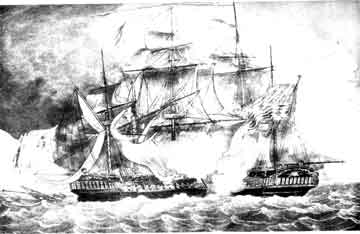Quasi War

The Quasi War may have been a “Quasi” War for most Americans, but for the men of US Navy it was a war in every sense of the word. Nearly 90 French privateers and other vessels were captured by the American Navy during the war. There were also a number of major sea battles that have gone down in the annals of sea warfare. The most famous was the victory of the Constellation over the L'Insurgent, supposedly the fastest frigate in the French fleet. Further, there was the battle of the Constellation with the La Vengeance a ship that was larger than the Constellation, but which the Constellation bested in battle. That battle ended when the La Vengeance managed to crawl away, but it later had to be abandoned.
The Quasi-War, which lasted from 1798 to 1800, may have been termed "quasi" due to its status as an undeclared naval conflict between the United States and France, but for the men serving in the U.S. Navy, it was a war in every tangible aspect. This conflict saw the young American Navy, barely two decades old, demonstrate its growing prowess on the high seas, engaging in numerous naval engagements that would come to be celebrated in the history of naval warfare.
During this period, the U.S. Navy, though still in its infancy, proved its mettle by capturing nearly 90 French privateers and other vessels. This accomplishment was significant, considering the French Navy's reputation and the limited resources and experience of the American Navy at that time. The capture of these vessels demonstrated the U.S. Navy's growing capabilities and significantly disrupted French privateering, which was aimed at undermining American trade.
One of the most notable engagements of the Quasi-War was the victory of the USS Constellation over the L'Insurgent. The L'Insurgent was reputed to be the fastest frigate in the French fleet, making its defeat a significant morale booster for the U.S. Navy and a testament to American naval design and seamanship. The Constellation, under the command of Captain Thomas Truxtun, outmaneuvered and outgunned the French frigate, showcasing the strategic and tactical prowess of the U.S. Navy.
Another significant engagement was the battle between the Constellation and La Vengeance, a French frigate larger than the Constellation. Despite the size and power disparity, the Constellation managed to best La Vengeance in a fierce battle. This engagement was particularly noteworthy for its intensity and the skill displayed by the American sailors. The battle ended with La Vengeance managing to escape, heavily damaged, and later had to be abandoned, further underscoring the effectiveness of the American naval strategy and firepower.
These battles, among others, cemented the Quasi War's place in naval history. They demonstrated the resolve and capability of the United States to protect its interests on the high seas. Furthermore, the conflict played a crucial role in the development of the U.S. Navy. The experience gained and the victories achieved helped build the reputation and efficacy of the U.S. Navy, setting the foundation for its future expansions and successes.
In essence, the Quasi-War, while perhaps "quasi" in its political and formal declaration, was a full-fledged war at sea. The conflict tested and ultimately validated the United States' naval capabilities, leaving a lasting impact on the nation's military history and its role in international maritime affairs.
 >
>